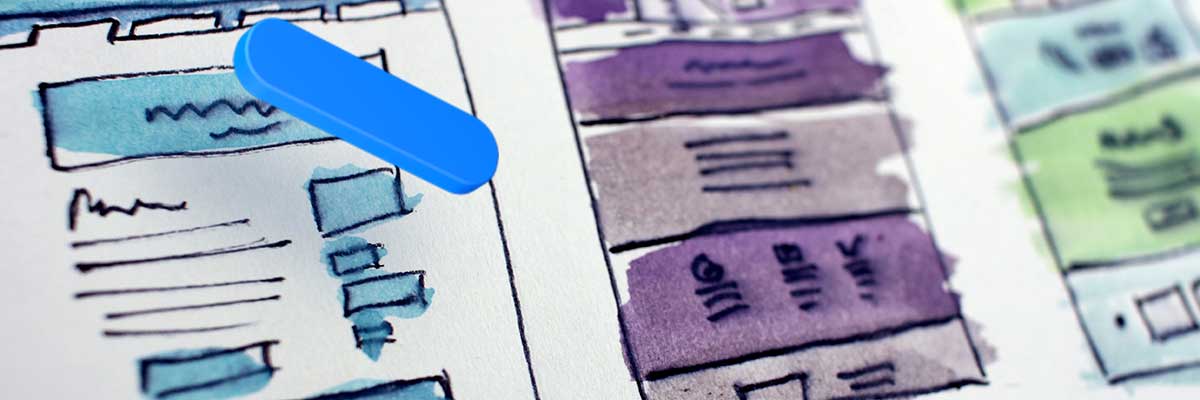

The digital world we live in is focusing on presenting information and content in many formats on various channels over a website. This means for 2021 web design to understand the site visitor more than ever before. The average person takes 0.05 seconds to form an opinion about a website. Since the majority of humans are visually orientated, 94% of those initial impressions are related to design elements.
Don’t lose visitors, sales, or social shares because of a sketchy web design – check out these trends and statistics, and make good design choices instead!
In 2021 web design is not much different than the years before, the big message is Putting Users First.
What do the statistics say about the different elements on our website? What are the key attention catcher, what makes the visitor come back or read more?
1. Photography with Graphics
Users spend looking 5.94 seconds at the website’s main image. Knowing that a person can leave in not even 4 seconds the website if they don’t find it interesting, then we know we broke the ice already.
38% of website visitors will leave unattractive websites.
WHY IT WORKS
Website visitors are shallow! According to Adobe, given 15 minutes, 66% of users would rather look at a beautifully designed website than a simple or plain one.
HOW TO USE IT
Use a photography/illustration blend as the main homepage image. Grab attention straight away by using a large, eye-catching image that blends photography with graphics.
Replace boring stock imagery with fresh, mixed graphics. Eye-tracking studies show people totally ignore generic stock imagery. This does not mean stock images are bad or wrong to use. However, if you can modify them and add more interesting elements to them it catches more attention. Also making your own exciting hero photo is easy even with an iPhone or mobile phone, they offer already great capabilities.
2. Bold Fonts
Did you know that most people read only 20% of the words on a webpage? This comes not only from the speed reading training which we observed over the last years which got popular. Eyes are scanning newspapers, magazines, or websites to find the most relevant information.
Websites score 47% higher in usability when text is scannable.
WHY IT WORKS
Bold text can bring a crisp, modern look to websites: They also serve a more functional pur pose – they make your pages scannable and easy to digest.
HOW TO USE IT
Pick out important information: Don’t put everything in bold – choose the text you want visitors to pay the most attention to, such as headings, calls to action, or key information.
Re-think your written content: Bold fonts and text-heavy pages are a recipe for disaster. Slim down your copy to make the most of bold fonts.
Adjust your page design to match: Increase white space and the size of your buttons to maintain a well-balanced design when using large, bold text.
3. Visual Hierarchy
Surprising is that we arrived in 2021 and 71% of websites for small businesses have no clear calls-for-action.
Business owners need to understand, 44% of people leave the website again if there a no contact details visualized correctly.
WHY IT WORKS
People are impatient: If they can’t find the information they’re looking for they will leave your site. The visual hierarchy gives the order to your design, making it more attractive and helpful for your visitors. Understanding visual hierarchy can help you arrange your design elements. Keep in mind, we might have experienced with the younger generation the habits of inpatient, but it swops over to all generations meanwhile with the information overload.
HOW TO USE IT
Give the people what they want: People have certain design expectations you should meet: logo, menu navigation, contact info, calls-to-action.
Think about size and space: People look at larger text and elements first, so you can guide their focus by playing with the size of important features.
Use color: Bright colors grab attention – use them sparingly to emphasize calls-to-action. Use contrasting, rather than clashing colors for best results.
4. Personalized Content
Remember, talk to me, don’t talk to the hand. 54% of users prefer personal rather than generic online experiences. This is not only generation Y and Z specific, it is effective for all ages of site visitors.
59% of buyers want real-time deals on items they like. They for sure will come back to see if promotions changed.
WHY IT WORKS
People want tailored experiences that speak directly to them and their location. Adding just a drop of personalization to any site can really boost engagement – 93% of companies have seen a boost in conversions after using personalization!
44% of consumers say they’re likely to become repeat buyers after a personalized/localized shopping experience with a particular brand.
HOW TO USE IT
Localize your checkout: Selling internationally? Ensure you’re selling in your customer’s language, currency, and offering familiar payment methods.
Provide real-time offers: Pop-ups, emails, and automatic discounts create a real-time, personalized customer experience.
Use cookies, geo-location, or sign-ups to personalize content: Tailor your content to individuals based on location, birthday, or browsing history – using their name in emails is a good start!
5. Mobile focused e-Commerce
The best marketing is still mouth-to-moth. Never forget that 57% of users won’t recommend a business with a poorly designed mobile site. It takes a second to share a side on the mobile and we don’t want to miss this momentum.
People are constantly on the road even during pandemic times people prefer not to sit in front of the computer. 70% of searches on mobile lead to action within one hour.
45% of consumers say they’re shopping on their phone more since March 2020. Shopping will never be the same even after the pandemic of COVID-19, online shopping got more attention than before.
WHY IT WORKS
In the first quarter of 2020, mobile e-commerce traffic grew by 25% to make up a whopping 71% of total traffic. Mobile now represents 56% of the total order share!
HOW TO USE IT
Keep your design clutter-free: Think about what visitors want from your site and give it to them straight away – cut distracting clutter away completely.
Use plenty of white/open space: Give elements such as buttons plenty of space – not only does it look good, it makes them easier to click on using a finger or thumb!
2021 Web Design goals are like the years before required to focus on mobile first for the majority of ecommerce users.
6. Faster Loading Speed
While many site visitors might be attracted by the first site photo, 40% of users will wait no longer than 3 seconds before abandoning a site.
The statistics state it clear, 0.1-second increase in mobile site speed can boost order value by 9.2%.
WHY IT WORKS
Your website should load in three seconds or less to keep visitors happy – and you’ll find it helps your SEO rankings in Google as well! 46% of people name waiting for pages to load as the thing they dislike most about mobile browsing, and just a one-second delay reduces customer satisfaction by 16%.
HOW TO USE IT
Compress your images: Put all images through a compressor tool before uploading them for a super-easy way to speed up your site!
Test your site speed: Your website should load in three seconds or less. Find out how fast your site really is by using a free tool such as Pingdom.
Check your hosting: Not sure why your site is so slow or keeps crashing? You could need to upgrade your hosting plan or switch web hosts completely.
Use smart content loading: This neat feature loads visible content first, then loads content further down the page afterward. In most of the CMS systems, it is named lazy loading, this can help you to improve the visualization of your site quicker before everything is loaded.
Summary
I am happy that WebsiteBuilderExpert brought all these findings together in this great infographic. The statistics don’t surprise me but I like the information on how to use them and why they are working. In most statics reports you will find the numbers and facts, but not how to avoid negative numbers or impact. Also in 2021 web design, our goal is to get loyal customers, site visitors, generate sales, and gain more social shares. With the mission to think mobile-first and user first we can achieve it. Keeping all these overwhelming numbers in mind and identifying that way around in the obstacle course in the digital world will support us to achieve our goals in the future.


![The Future of Jobs Report 2025 [Infographic] hero-image-the-future-of-jobs-report](https://www.skillzme.com/wp-content/uploads/2025/02/hero-image-the-future-of-jobs-report-200x200.jpg)
![90% of Americans Think iPhone 16 Cost Too Much [Infographic] 90% of Americans Think iPhones 16 Cost Too Much](https://www.skillzme.com/wp-content/uploads/2025/02/hero-image-iphone-16-200x200.jpg)
![A Look Inside the Future of BIM [Infographic] A Look Inside the Future of BIM hero image](https://www.skillzme.com/wp-content/uploads/2025/01/hero-image-the-future-of-bim-200x200.jpg)


October 7, 2017 More than a quarter (29 percent) of Middle East consumers now shop online every month. 36% of those Middle East shoppers surveyed between ages 18 and 24 shop online monthly compared to 13% of those ag.. “I literally admire their response for the hosting services, no matter what time of the day, I have received reply in less then 5 minutes.”